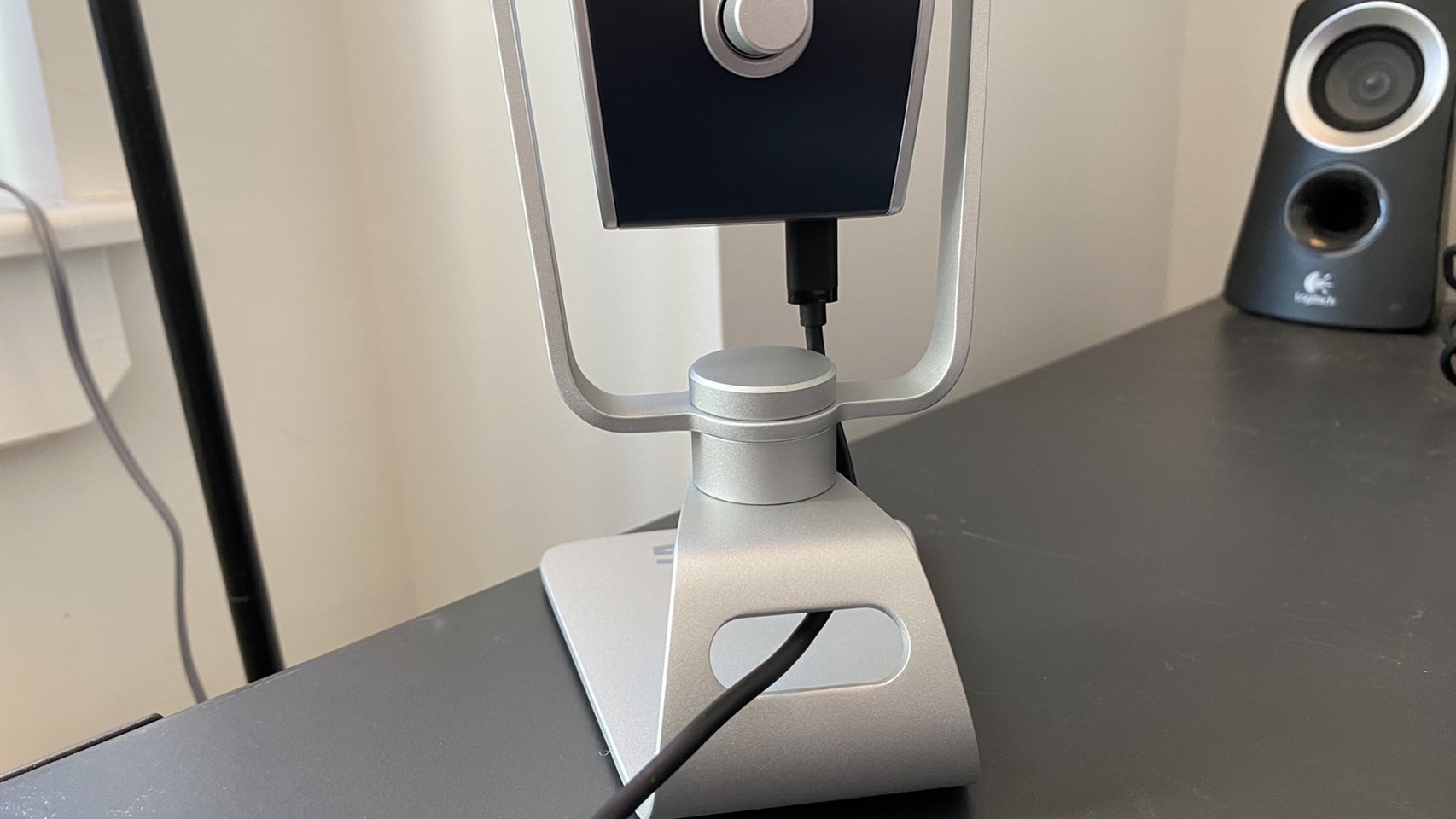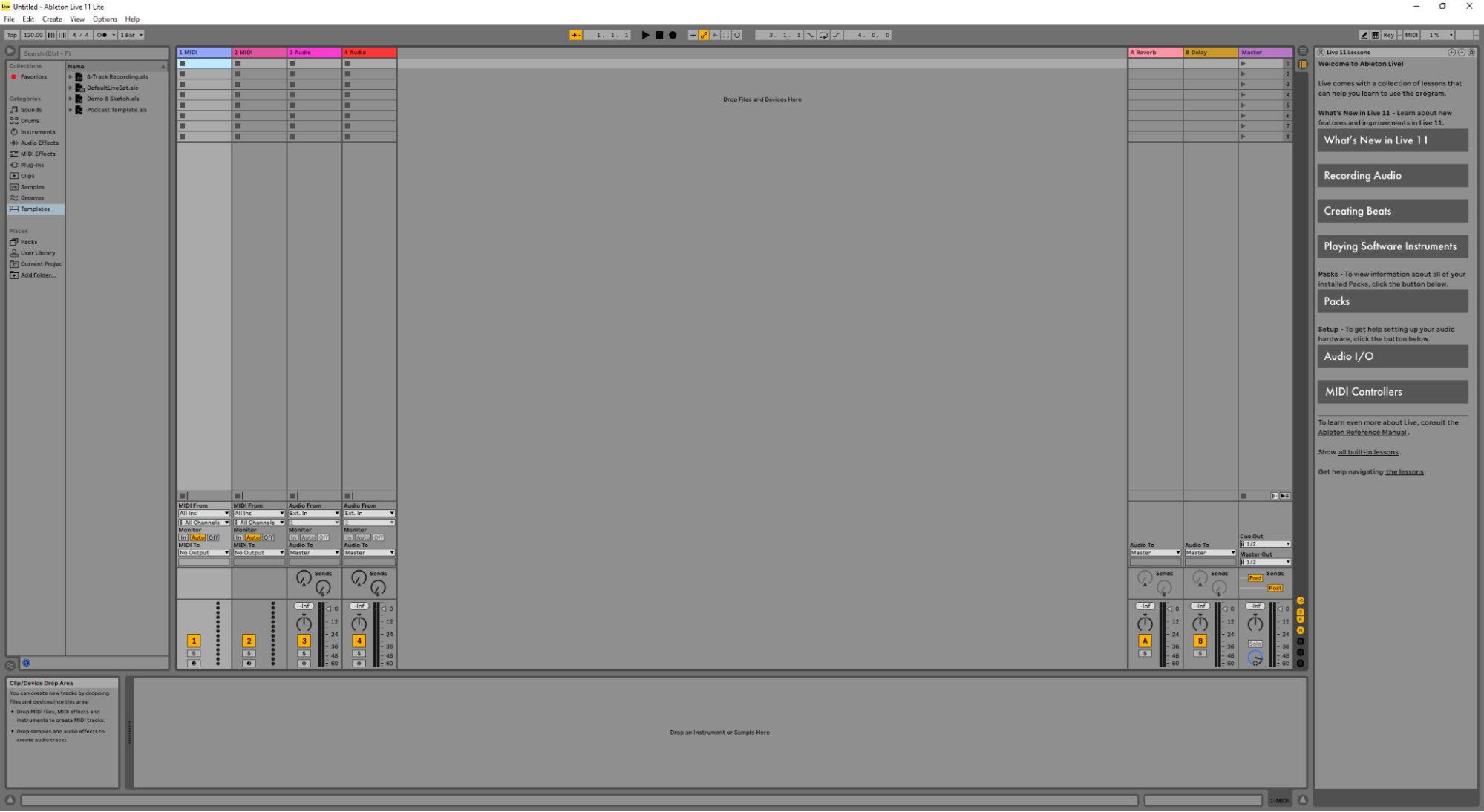Tom's Hardware Verdict
The AKG Ara and Lyra are great microphones in a vacuum, but a vacuum is the least likely environment for a USB device. The lack of pickup patterns on the Ara and the poor background noise negation on both makes these microphones ideal only for pre-recorded material.
Pros
- +
+ High sample rates
- +
+ Great general sound
- +
+ Stylish looks
- +
+ Free Ableton Live 11 Lite
Cons
- -
Lack of controls
- -
Software only useful for some
- -
Lack of pickup patterns on Ara
- -
Poor background noise negation
Why you can trust Tom's Hardware
The best gaming microphones don’t just need to offer high-quality sound. They also need to have a variety of useful pickup patterns, come with intuitive controls and block out background noise. AKG, an offshoot of Harman, is a popular and well-respected audio engineering company that professionals swear by. But its newest USB microphones, the AKG Ara and AKG Lyra, perhaps lean too far into that legacy.
While they offer astonishingly high sample rates and high-quality general sound in an ideal environment, both their microphone capsules and software aren’t built for a livestreaming environment or the harsh realities of recording from a desk. While they might be useful for some amateur musicians or podcasters, so are other USB microphones that also handle streaming well. In other words, these aren’t built to handle the wide variety of use cases most USB microphones have to contend with, and instead come across as lesser versions of AKG’s professional-level gear.
AKG Ara and Lyra Specs
| Header Cell - Column 0 | AKG Ara | AKG Lyra |
|---|---|---|
| Sample Rate | 96 kHz | 192 kHz |
| Bit Rate | 24-bit | 24-bit |
| Frequency Response | 20 Hz- 20 kHz | 20Hz - 20 kHz |
| Polar Patterns | Front (Cardioid), Front & Back (SuperCardioid) | Front (Cardioid), Front & Back (SuperCardioid), Tight Stereo, Wide Stereo |
| Max SPL | 120 dB | 129 dB |
| Dimensions (in stand) | 8.70 x 3.20 x 3.50 inches (221 x 81.2 x 88.9mm) | 9.72 x 4.23 x 6 inches (247.5 x 107.9 x 152.5mm) |
| Weight (in stand) | 1.48 pounds (671g) | 1.95 pounds (886g) |
| Connectivity | USB-C to USB-A | USB-C to USB-A |
| Price | $99 | $149 (site lists on sale for $124) |
Designs of AKG Ara and AKG Lyra
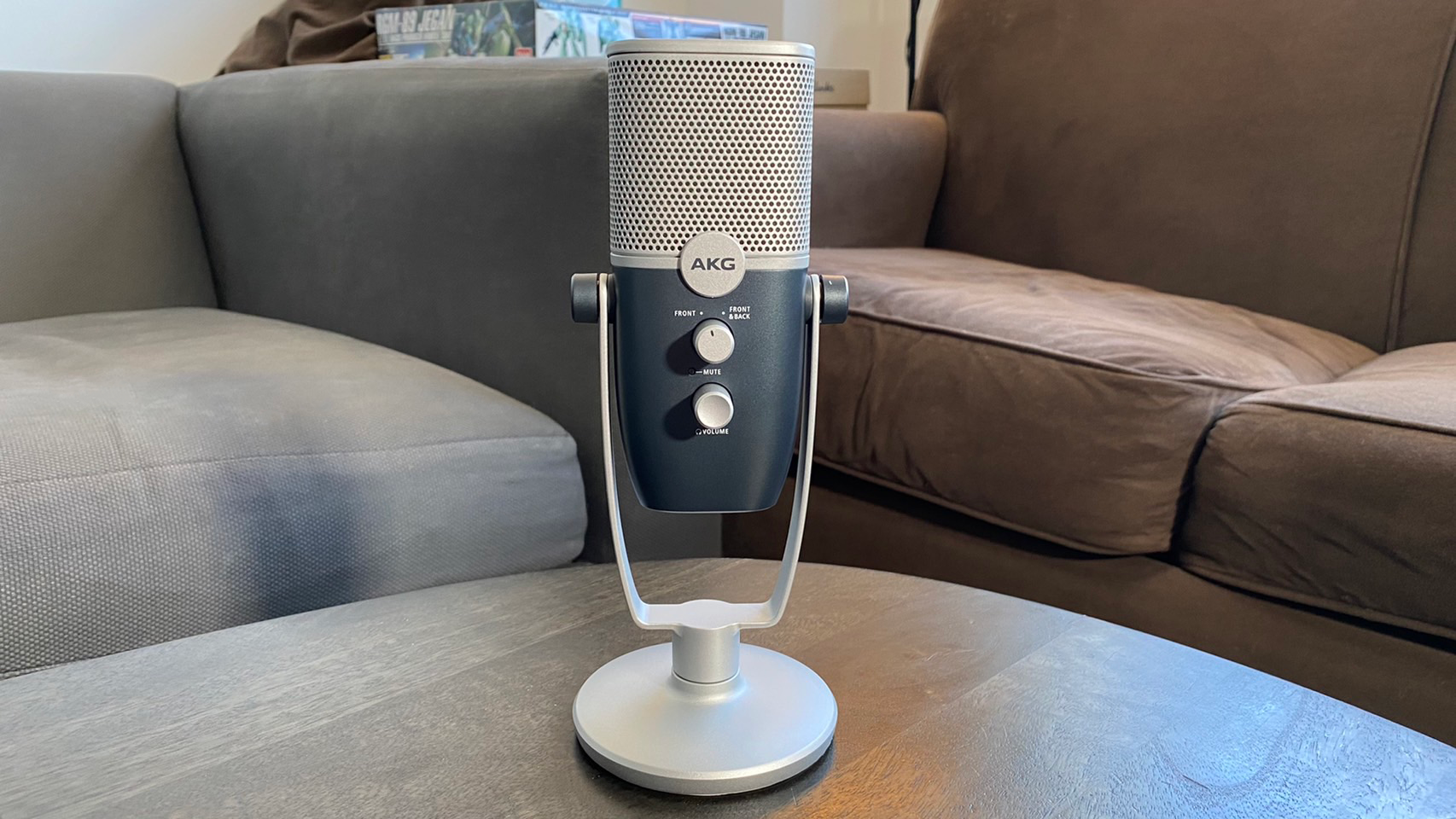
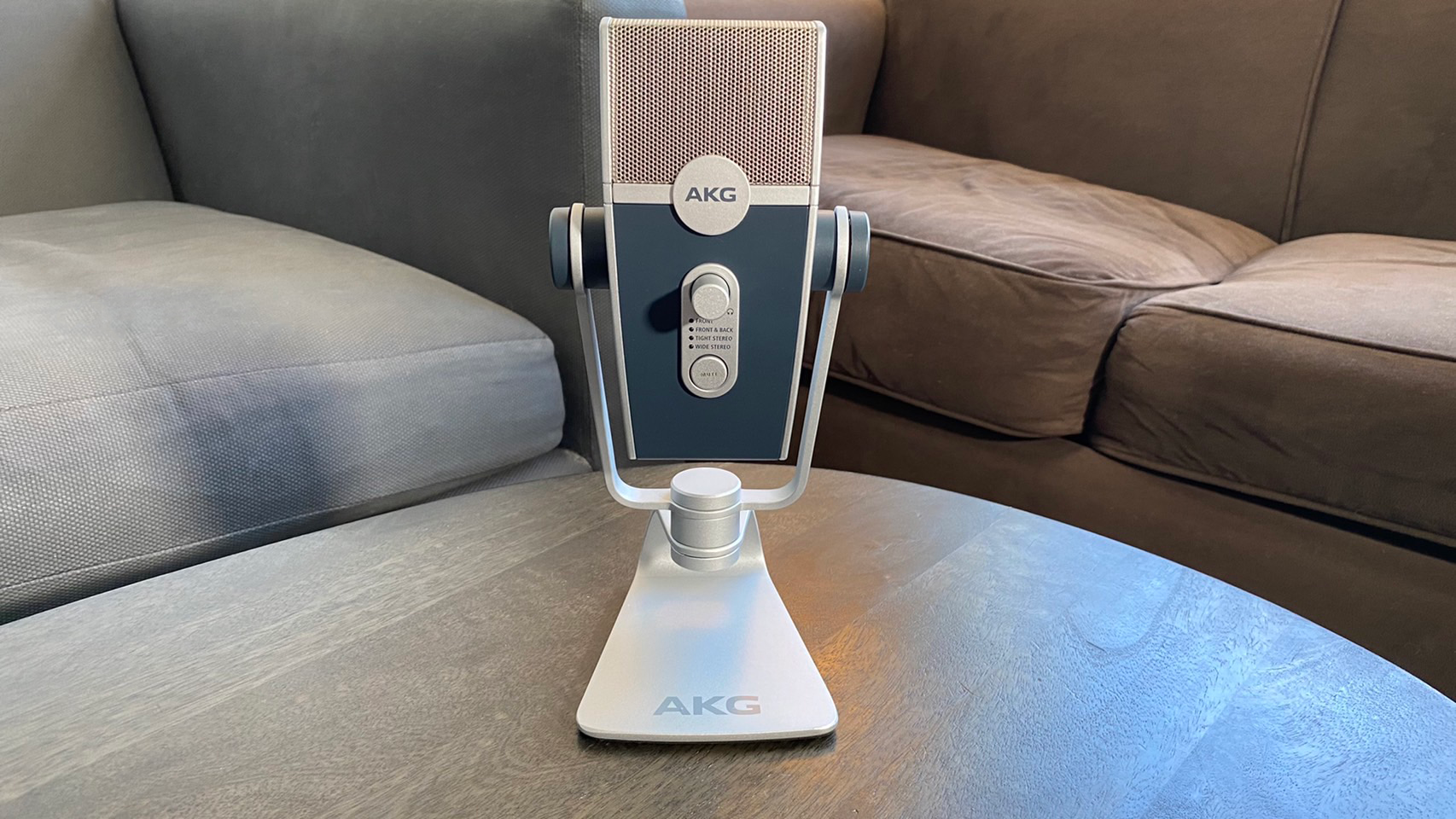
The AKG Ara and especially the Lyra each look like they belong in your hometown’s local radio station. Both are wrapped in a metallic silver aesthetic and sport a boxy shape that gives each mic both some retro charm and professional credibility. This is doubly true on the Lyra, which accentuates the design with amber-tinted grating around its microphone capsule. The effect rings a touch false once you realize how much of each microphone’s body is plastic vs metal, as only the stands appear to be as metal as they look here. But that’s an understandable concession, and won’t impact usability. What might prove to be a problem is the lack of controls, at least on the Ara.
The AKG Ara’s only on-mic controls are a polar pattern dial and an in-headset monitoring volume dial. You can also click the volume dial in to mute the microphone, but that’s it. There are no gain controls to be found here. That’s a bit disappointing given the complexity of this microphone’s software, but it’s not the only issue here. Even among the existing controls, it’s disappointing that the mute feature is combined with the headset volume dial. It’s easy to accidentally adjust the volume when pushing the dial in to mute the microphone, so I have to wonder why we didn’t get a stand-alone mute button instead. The pickup pattern dial also only has two options to select from, so it’s not like space couldn’t have been cleared up by not giving this feature a full dial.

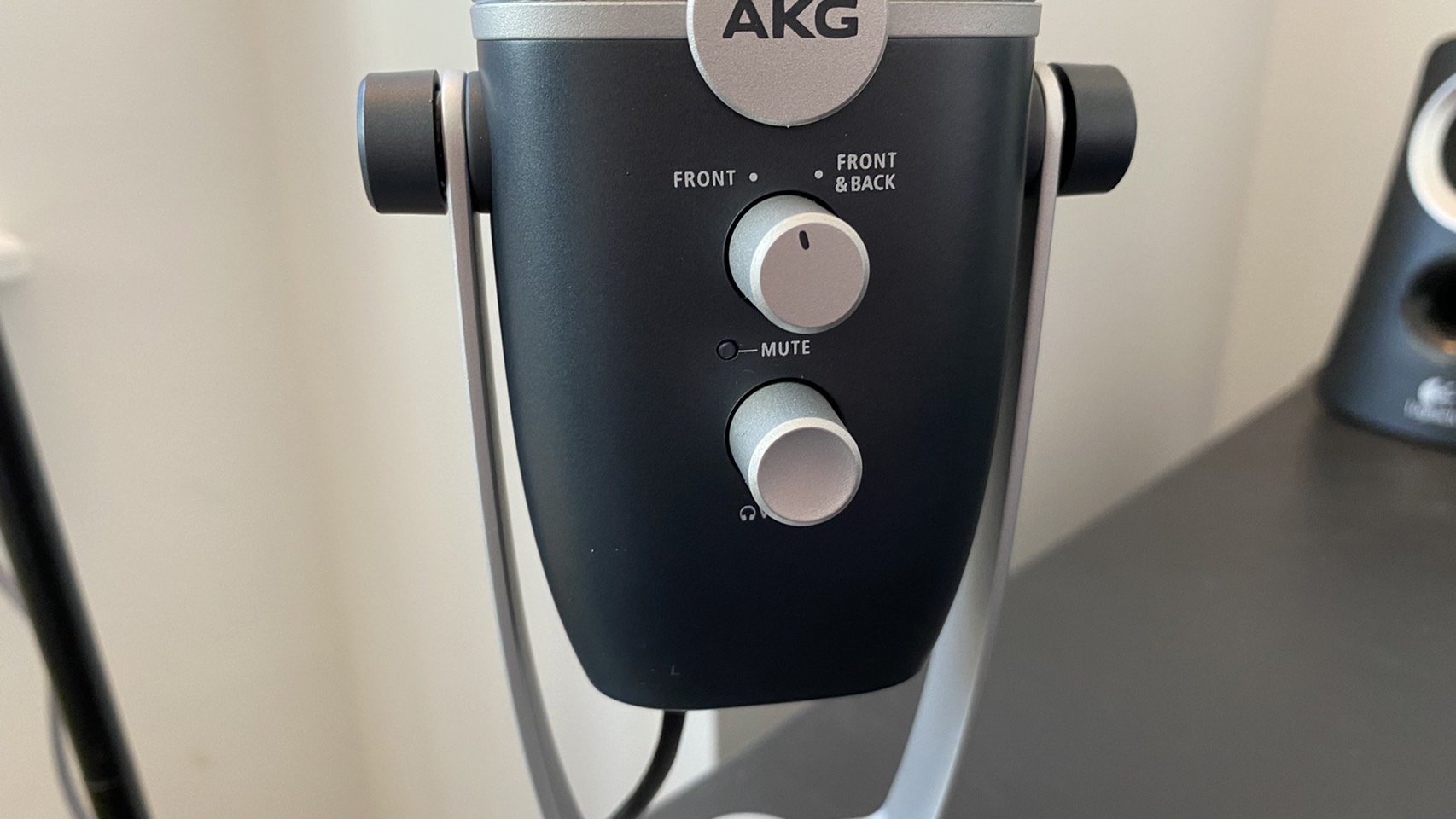
The Lyra fares better in the on-mic controls department. While some of its dials have been moved from the microphone’s front to its back, which makes for a generally less comfortable experience than the Ara, where all of its controls on the front of the device, there are plenty of dials and buttons here. Not only is there now a dedicated mute button, but there’s also a microphone gain dial as well. There are also LEDs indicating both your mute status and which polar pattern you’re using, but the polar pattern LED array is confusingly placed below the headset volume dial as opposed to near the pickup pattern dial.
On both microphones, all dials have smooth movement, except for the pickup pattern ones. That’s a touch disappointing, as notched dials not only help users tune these knobs more precisely, but also let them easily keep track of their volume or gain percentage once they’re finished with a dial.
Adjustability is strong on both the Ara and Lyra, as both microphones can tilt 360 degrees in their stands. They can also be removed from their stands and mounted on either a ⅜-inch or ⅝-inch boom arm, as each comes with a 3/8-to-5/8 adapter in the box.
Get Tom's Hardware's best news and in-depth reviews, straight to your inbox.
Both microphones are also reasonably tall without becoming cumbersome, with the Ara reaching about 8.7 inches in its stand and the Lyra reaching about 9.4 inches in its stand. By comparison, the Blue Yeti is taller at about 11.25 inches in its stand. Additionally, the USB-C to USB-A cable has plenty of room to hook into both mics, with the Lyra even including a cable management hole for it.
Sound Quality of AKG Ara and Lyra
Out of the box, my first impression of the AKG Ara was that its quality is roughly on par with, if not slightly higher than, what you might expect from other $100 USB microphones like the Blue Yeti or Joby Wavo Pod. The Lyra, at an MSRP of $150 (although it’s been on sale for $124 for a few weeks prior to the writing of this review), is noticeably crisper and warmer, creating an even more pleasant effect. With the former bearing a sample rate of 96 kHz and the latter a sample rate of 192 kHz, high-quality audio is to be expected. Still, pure audio quality isn’t everything, especially on a USB device.
Let’s start with the positives. On both microphones, both the bass and treble of my voice came across accurately when I was whispering and speaking normally. There wasn’t any fuzz or interference in the background, and it was difficult to peak both microphones even with sudden loud plosive sounds. When leaning in close to each microphone, my voice also sounded warm and pleasant in an ASMR-like style, despite the lack of a binaural build. That last point is especially true on the AKG Lyra, thanks to having the option to swap to its “Tight Stereo” pickup pattern.
However, when we discuss pickup patterns, the AKG Ara starts to falter. Since it only has two pickup patterns, labeled “Front” and “Front & Back,” it’s less versatile than other $100 microphones like the Blue Yeti. These patterns function similarly to a cardioid and omnidirectional pickup pattern, respectively. That’s because, despite “Front & Back” sounding more like a supercardioid pattern in its name, the drop in audio quality from the “Front” setting is strong enough that I wouldn’t use the “Front & Back” setting for any professional purposes. That’s not the case on supercardioid patterns I’ve tested. Also, audio quality sounded the same, i.e. poor, on the “Front & Back” setting even when speaking into the side of the device. While the “Front” pattern still sounds stellar, this means the microphone really only comes with one usable pickup pattern, as opposed to the 3 patterns on the Blue Yeti (the Blue Yeti also includes an omnidirectional pattern, although I wouldn’t recommend it either).
The Lyra has a stronger pickup pattern game. While the “Front” and “Front & Back” patterns are also here, there are two additional stereo patterns as well. These include “Tight Stereo” and “Wide Stereo,” which essentially translates to “stereo sound from the front only” and “omnidirectional stereo sound.” Both work well in separating audio into left and right channels, which is great for music recording artists and for lending an ASMR-like feel to your streams. The “Tight Stereo” pattern’s audio quality is roughly on par with the “Front” pattern’s, but the “Wide Stereo” pattern’s fidelity is somewhere in between that and the abysmal “Front & Back pattern.” AKG suggests using Wide Stereo when multiple speakers are in one room, and the microphone did perform admirably when capturing both myself and my boyfriend, even though I was sitting directly in front of the microphone and he was halfway across the room. If you’re recording a podcast and can’t splurge on an individual mic for each host, “Wide Stereo” is a decent enough, if still suboptimal, option.
Unfortunately for AKG, both mics fall short when it comes to filtering out background noise. Despite my keyboard sitting behind each microphone when I tested it, the “Front” pattern still picked it up with such accuracy that it’s like it was directly in front of the mic. This also happened when I clicked my mouse, even though it sat to the side of the microphones during testing. It’s winter in New York, too, and both microphones picked up my heater when it turned on while recording.
In a perfect recording environment, the Lyra and even the Ara are among the best sounding microphones I’ve used. But while they’re still good in a realistic environment, they fall prey to background noise and having fewer options than some contemporaries. Their high sample rates also won’t matter much on most modern streaming platforms, which top out at a recommended sample rate of 48 kHz. For these reasons, I’d most recommend these microphones for controlled recording sessions that are going to be edited later.
Software of AKG Ara and Lyra
Meshing well with the idea that the AKG Ara and Lyra are best suited for recording audio in a controlled environment rather than live streaming, each microphone comes with a key for accessing Ableton Live 11 Lite. This is a somewhat stripped-down version of Ableton Live 11, a popular piece of music production software that’s not unique to these microphones in any way. Live 11 Lite’s license lasts for a lifetime and can only be acquired by purchasing partner products like these mics. And because it’s still fairly robust despite being stripped down, that makes the Ara and Lyra great deals if you’re a budding audio engineer. For everyone else, though, it won’t be of much use in actually configuring your microphones.
Despite having a fairly complex UX that’s so in-depth that the program comes with lessons on how to use it, nothing here is purpose-built for the Ara and Lyra. Instead, you just get access to a suite of various generic EQs, virtual instruments and clip samples. This is a powerful program, but its use is limited for some audiences. First, it’s not a great option if you just want to jump in and quickly tweak settings, like your microphone’s gain. Second, it can’t affect live audio, despite its name, making it useless to streamers. Both of these are especially disappointing for Ara owners, as Live 11 Lite can’t make up for that mic’s lack of a gain dial through something like a simple slider, nor can it ape functionality like the Razer Seiren V2 Pro’s or Razer Seiren V2 X’s automatic gain limiter. In other words, this is less software specifically for your microphone and more a bonus audio production program that happens to come with your device.
Bottom Line
Rating the AKG Ara and Lyra is difficult, because for certain users, they’re perfect microphones. They have a high sample rate, sound great under ideal conditions and come with free access to Ableton. If you’re an audio engineer, a musician or even a podcaster looking to put out highly produced sound, they’re good options with lots of value. But USB microphones are made to live on a desk, surrounded by background noise like keyboards and air conditioners or heaters. They’re also supposed to be convenient and all-purpose, and be usable for livestreaming. That’s the compromise you make when you choose a USB microphone— you’re sacrificing some audio fidelity and control for greater convenience and a wider set of potential use cases. Looking at them through this lens, the Ara and Lyra are impressive, but stumble when compared to competitors like the Blue Yeti or the HyperX Quadcast.
While these are less professionally prestigious options, they still handle podcasts and music well while also offering a wider array of pickup patterns and background noise negation that make them more useful across a larger number of use cases, including livestreaming. This is the ethos of the USB mic, and it’s something I’d like to see AKG focus on more directly in future refreshes of the Ara and Lyra lines.
Michelle Ehrhardt is an editor at Tom's Hardware. She's been following tech since her family got a Gateway running Windows 95, and is now on her third custom-built system. Her work has been published in publications like Paste, The Atlantic, and Kill Screen, just to name a few. She also holds a master's degree in game design from NYU.
